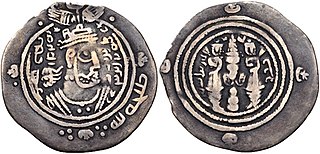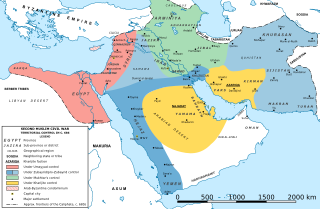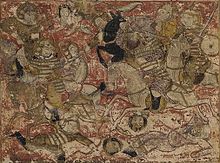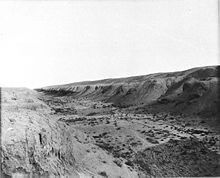
Mu'awiya I was the founder and first caliph of the Umayyad Caliphate, ruling from 661 until his death. He became caliph less than thirty years after the death of the Islamic prophet Muhammad and immediately after the four Rashidun ('rightly-guided') caliphs. Unlike his predecessors, who had been close, early companions of Muhammad, Mu'awiya was a relatively late follower of Muhammad.

Ali ibn Abi Talib was the cousin and son-in-law of the Islamic prophet Muhammad, and was the fourth Rashidun caliph who ruled from 656 to 661, as well as the first Shia imam. Born to Abu Talib ibn Abd al-Muttalib and Fatima bint Asad, a young Ali was raised by his elder cousin Muhammad and was among the first to accept his teachings.

Hasan ibn Ali was an Alid political and religious leader. The eldest son of Ali and Fatima and a grandson of the Islamic prophet Muhammad, Hasan briefly ruled as caliph from January 661 until August 661. He is considered as the second Imam in Shia Islam, succeeding Ali and preceding his brother Husayn. As a grandson of the prophet, he is part of the ahl al-bayt and the ahl al-kisa, and also participated in the event of mubahala.

Marwan ibn al-Hakam ibn Abi al-As ibn Umayya, commonly known as Marwan I, was the fourth Umayyad caliph, ruling for less than a year in 684–685. He founded the Marwanid ruling house of the Umayyad dynasty, which replaced the Sufyanid house after its collapse in the Second Fitna and remained in power until 750.

The Election of Uthman refers to the appointment of Uthman ibn Affan as the third caliph by a committee, which was assembled by the dying caliph Umar in 23 AH. The committee likely consisted of six early Muslims from the Quraysh tribe, including the prophet Muhammad's second cousin and son-in-law Uthman and Muhammad's first cousin and son-in-law Ali ibn Abi Talib. The deciding vote was given to Uthman's brother-in-law Abd al-Rahman ibn Awf, who appointed the former as the next caliph after the deliberations stalled. The choice of the wealthy Uthman is often explained as intended to guard the interests of the Quraysh and to follow the practices of the first two caliphs, namely, Abu Bakr and Umar. The committee has been criticized for its bias towards Uthman and for its exclusion of the Ansar.
Umm Kulthūm bint 'Alī, also known as Zaynab al-Ṣughrā, was the youngest daughter of Fatima and Ali ibn Abi Talib. The former was the daughter of the Islamic prophet Muhammad and the latter was his cousin. Ali is also recognized as the fourth Rashidun caliph and the first Shia imam. A young Umm Kulthum lost her grandfather and mother in 632 CE. While she was still a child, the second Rashidun caliph Umar ibn al-Khattab asked for her hand in marriage, which was resisted by Umm Kulthum and her father Ali, possibly due to Umar's reputation for harsh treatment of women. By one Sunni account, Ali finally agreed to the marriage when Umar enlisted the support of prominent Muslims for his proposal.

Abd Allah ibn al-Zubayr ibn al-Awwam was the leader of a caliphate based in Mecca that rivaled the Umayyads from 683 until his death.
The Battle of Siffin was fought in 657 CE between the fourth Rashidun caliph Ali ibn Abi Talib and the rebellious governor of Syria Mu'awiya ibn Abi Sufyan. The battle is named after its location Siffin on the banks of the Euphrates. The fighting stopped after the Syrians called for arbitration to escape defeat, to which Ali agreed under pressure from some of his troops. The arbitration process ended inconclusively in 658 though it strengthened the Syrians' support for Mu'awiya and weakened the position of Ali. The battle is considered part of the First Fitna and a major step towards the establishment of the Umayyad Caliphate.

Ali ibn Abi Talib was the cousin and son-in-law of the Islamic prophet Muhammad. Ali contributed significantly to Islam in its early years and was likely the first male to accept the teachings of Muhammad. Ali is accorded an almost legendary place in Islam as a paragon of virtues, a fount of wisdom, and a fearless but magnanimous warrior. In Shia Islam Ali is regarded as the foremost companion of Muhammad and his rightful successor through divinely-ordained designation at the Ghadir Khumm.

Ali ibn Abi Talib was the cousin and son-in-law of the Islamic prophet Muhammad. Ali contributed significantly to Islam in its early years and was likely the first male to accept the teachings of Muhammad. In Sunni Islam, Ali is recognized as a close companion, a foremost authority on the Quran and Islamic law, and the fountainhead of wisdom in Sunni spirituality. When Muhammad died in 632 CE, Ali had his own claims to leadership, perhaps in reference to Muhammad's announcement at the Ghadir Khumm, but he eventually accepted the temporal rule of the first three caliphs in the interest of Muslim unity. During this period, Ali is portrayed in Sunni sources as a trusted advisor of the first three caliphs, while their conflicts with Ali are neutralized or downplayed. Ali himself succeeded to the caliphate in 656 but his rule was immediately challenged by multiple pretenders and he was assassinated in 661.

The Battle of Nahrawan was fought between the army of Caliph Ali and the rebel group Kharijites in July 658 CE. They were a group of pious allies of Ali during the First Fitna. They separated from him following the Battle of Siffin when Ali agreed to settle the dispute with Mu'awiya, governor of Syria, through negotiations, a move labeled by the group as against the Qur'an. After failed attempts to regain their loyalty and because of their rebellious and murderous activities, Ali confronted the Kharijites near their headquarters by the Nahrawan Canal, near modern-day Baghdad. Of the 4,000 rebels, some 1,200 were won over with the promise of amnesty while the majority of the remaining 2,800 rebels were killed in the ensuing battle. Other sources put the casualties at 1500–1800.

The Hasan–Mu'awiya treaty was a political peace treaty signed in 661 between Hasan ibn Ali and Mu'awiya I to bring the First Fitna (656–661) to a close. Under this treaty, Hasan ceded the caliphate to Mu'awiya on the condition that the latter should rule in compliance with the Quran and the sunna, a council should appoint his successor, and Hasan's supporters would receive amnesty. Upon accession, Mu'awiya publicly recanted his earlier promises, while Hasan retired from politics in Medina, and was later killed in 670 by poisoning. Mu'awiya is commonly viewed as the instigator in the murder of Hasan, which removed an obstacle to the succession of his son Yazid, whose nomination violated the treaty with Hasan. Throughout his reign, Mu'awiya also prosecuted notable partisans of Hasan and his father Ali.

The Second Fitna was a period of general political and military disorder and civil war in the Islamic community during the early Umayyad Caliphate. It followed the death of the first Umayyad caliph Mu'awiya I in 680, and lasted for about twelve years. The war involved the suppression of two challenges to the Umayyad dynasty, the first by Husayn ibn Ali, as well as his supporters including Sulayman ibn Surad and Mukhtar al-Thaqafi who rallied for his revenge in Iraq, and the second by Abd Allah ibn al-Zubayr.
Cursing Ali was a state policy introduced by Mu'awiya ibn Abi Sufyan, the first Umayyad caliph, which mandated publicly cursing Ali ibn Abi Talib, the cousin and son-in-law of the Islamic prophet Muhammad, who was also the fourth Rashidun caliph and the first Shia Imam. Mu'awiya was the incumbent governor of Syria who had rebelled against Ali ostensibly to avenge the previous caliph Uthman, who was in turn assassinated by some provincial dissidents angered by his policies. Ali and Mu'awiya fought the inconclusive Battle of Siffin in 657 CE and remained enemies until the assassination of Ali in 661, which paved the way for the caliphate of Mu'awiya in the same year. The public cursing of Ali continued after Mu'awiya and was finally abandoned some sixty years later by the pious Umar II. The policy likely served as a propaganda measure, and also helped provoke, identify, and then crush the supporters of Ali, whom the Umayyads considered a threat.

Administrative policies of Ali ibn Abi Talib highlights the policies of Ali, the son-in-law and cousin of the Islamic prophet Muhammad. Ali is recognized as the first Shia imam and the fourth Rashidun caliph. He was acclaimed as the caliph in 656 CE after the assassination of his predecessor Uthman, who was killed by Egyptian rebels amidst widespread accusations of nepotism, injustice, and corruption. Ali undertook radical changes upon accession and his strictly egalitarian policies garnered him the support of underprivileged groups while alienating the powerful Quraysh tribe, some of whom revolted against Ali under the pretext of revenge for Uthman in the Battle of the Camel (656) and the protracted Battle of Siffin (657). The latter fight ended in arbitration and led to the creation of the Kharijites, a member of whom is thought to be responsible for the assassination of Ali in 661. For some, the brief caliphate of Ali was characterized by his honesty, his unbending devotion to Islam, his equal treatment of the supporters, and his magnanimity towards his defeated enemies, while others criticize his policies for idealism and lack of political expediency.

The Battle of the Camel took place outside of Basra, Iraq, in 36 AH. The battle was fought between the army of the fourth caliph Ali, on one side, and the rebel army led by Aisha, Talha and Zubayr, on the other side. Ali was the cousin and son-in-law of the Islamic prophet Muhammad, while Aisha was a widow of Muhammad, of whom Talha and Zubayr were both prominent companions. Ali emerged victorious from the battle, Talha and Zubayr were both killed, and Aisha was sent back to Hejaz afterward. The triumvirate had revolted against Ali ostensibly to avenge the assassination of the third caliph Uthman, although Aisha and Talha are both known to have actively opposed him. The three also called for the removal of Ali from office and for a Qurayshite council (shura) with Talha and Zubayr to appoint his successor.
The Umayyad dynasty or Umayyads was an Arab clan within the Quraysh tribe who were the ruling family of the Caliphate between 661 and 750 and later of al-Andalus between 756 and 1031. In the pre-Islamic period, they were a prominent clan of the Meccan tribe of Quraysh, descended from Umayya ibn Abd Shams. Despite staunch opposition to the Islamic prophet Muhammad, the Umayyads embraced Islam before the latter's death in 632. Uthman, an early companion of Muhammad from the Umayyad clan, was the third Rashidun caliph, ruling in 644–656, while other members held various governorships. One of these governors, Mu'awiya I of Syria, opposed Caliph Ali in the First Muslim Civil War (656–661) and afterward founded the Umayyad Caliphate with its capital in Damascus. This marked the beginning of the Umayyad dynasty, the first hereditary dynasty in the history of Islam, and the only one to rule over the entire Islamic world of its time.

Ali ibn Abi Talib, the fourth Rashidun caliph and the first Shia Imam, was assassinated during the morning prayer on 28 January 661 CE, equivalent to 19 Ramadan 40 AH. He died of his wounds about two days after the Kharijite dissident Ibn Muljim struck him over his head with a poison-coated sword at the Great Mosque of Kufa, located in Kufa, in present-day Iraq. He was about sixty-two years of age at the time of his death.

Ali ibn Abi Talib was acclaimed in 656 CE as the fourth caliph after the death of the Islamic prophet Muhammad. Following the 656 assassination of the third caliph Uthman in Medina by provincial rebels who had grievances about injustice and corruption, the prophet's cousin and son-in-law was elected to the caliphate by the rebels, the Ansar, and the Muhajirun. While the election of Ali faced little opposition, his support was limited among the Quraysh, some of whom aspired to the caliphate. The Umayyads and some others thereby left Medina––some thus breaking their oaths of allegiance––and soon rebelled against Ali.

The second Syria campaign of Ali refers to the abortive efforts of Ali ibn Abi Talib, the Muslim caliph and the first Shia Imam, to organize a renewed military campaign against Mu'awiya, the rebellious governor of Syria. Following the indecisive Battle of Siffin against Mu'awiya in 657 CE, Ali subdued the Kharijites revolt in the Battle of Nahrawan in 658, but his military coalition in Iraq collapsed afterward when the tribal chiefs withdrew their support, as they hoped for peace with Mu'awiya on beneficial terms. Ali henceforth could barely muster enough force to repel the frequent raiding parties dispatched by Mu'awiya to harass the civilian population loyal to Ali. Egypt too fell to Mu'awiya in 658, further limiting the influence of Ali outside of Iraq. Following the raid of Busr ibn Abi Artat in 661, however, the public outrage against Mu'awiya finally seems to have galvanized the Iraqis' support for war, and a large offensive was planned for the late winter. These plans were abandoned after the assassination of Ali by the Kharijite Ibn Muljam on 26 January 661, during the morning prayers. His assassination paved the way for Mu'awiya, who later founded the Umayyad Caliphate.














